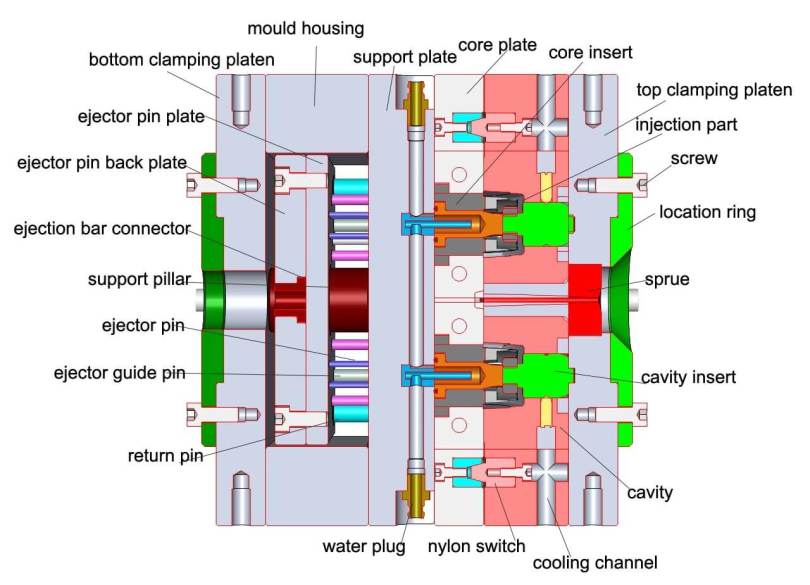Strategic injection molding and tooling procurement is the process of establishing service supply channels at the lowest total cost, and is a systematic, data analysis-based procurement method.
On the one hand, through understanding the injection molding and tooling supplier’s production capacity and market conditions, the company helps the company to strategically introduce competition into the supply system to reduce procurement costs

on the other hand, it can effectively control its demand by helping the injection molding and tooling company to better understand the internal demand model.
Strategic procurement includes the following important principles:
Consider the total cost
the total cost is not a single purchase price, but includes the entire process from injection molding and tooling pricing to material delivery, storage, use, conversion to the corresponding product, until the product is accepted or complained by the customer. The sum of expenditures;
Turning negotiations into commercial negotiations
Negotiation with suppliers is not a negotiation between rivals, but a process of business negotiation, based on a full understanding of the market and in line with the long-term communication of the company’s own long-term planning.
Total injection molding and tooling cost analysis, supplier evaluation, and market assessment provide factual and data information for this process, helping companies to understand their bargaining powers and thus master the entire negotiation process and initiative;
Establish a partnership based on a win-win situation
the win-win concept is rarely used in procurement. Most people like us to be knives and others are fish; but the win-win concept is an indispensable factor in strategic procurement.
A stable partnership must adhere to the principle of win-win
Cooperation based on checks and balances
There is a process of mutual comparison and mutual selection between enterprises and suppliers. If there is sufficient understanding of the industry, supplier’s business strategy, operation mode and competitive advantage of the supplier, It can help companies find opportunities and find a balance in win-win cooperation.
Strategic procurement implementation
Centralized procurement
Through the concentration of procurement to improve bargaining power and reduce unit procurement costs; many group-developed enterprises usually have their own branches in procurement, which greatly affects the purchasing advantages and can be adopted through the platform. Resolve and other methods to solve;
Expanding the supplier base
Introducing more competition by expanding supplier selection can help enterprises find the optimal resources, ensure the maximum utilization of resources, and reduce procurement costs;
Optimize the procurement process
To achieve strategic procurement, develop a reasonable process, and use the process as a basis for procurement and a tool for process control;
Unified products and services
During the procurement process, we will take into consideration ongoing costs of storage and transport, maintenance, consumables replenishment, product replacement and other issues, and strive to improve uniformity and make costs lower.
The development trend is going from traditional procurement to strategic procurement.
Many people are questioning what are the main differences among strategic procurement and traditional procurement. Let’s look at the factors below to see how they vary from the traditional procurement.
- Changing the focus of the bought
In traditional procurement, the entire price of a procurement is just focused on the unit price, as well as the other aspects, including quality and inventory, are overlooked. Strategic procurement focuses on the entire costs, and views the device price as part of the overall.
- Changes in supply string
Due to the fact that traditional purchase emphasizes the unit price a lot more than the total cost, it generally relies on multiple means of identifying suppliers, which leads to a lot of suppliers; on the other hand, strategic purchase emphasizes the centralized purchase process that reduces the amount of suppliers;
Note that a single provider involves the company’s interactions with multiple suppliers, choosing the best types, establishing a long-term supportive relationship, and doing extremely centralized procurement, thus assisting reduce risks and costs.
- Supplier relationships
Relating to historical trends, traditional procurement suppliers are significantly converting to strategic purchase suppliers. Companies’ transactions with most suppliers are immediate, simple trading relationships, whilst strategic procurement regards suppliers as partners, and is devoted to long-term cooperation;
- The changing role of the purchase department
It is widely regarded as that traditional procurement is known as a transactional work. Essentially, procurement functions only passively on behalf of the demand division.
Strategic procurement emphasizes the professionalism of procurement and requires the participation of procurement from the outset, to be able to confirm daily business requirements, early involvement includes both early involvement of suppliers and involvement of the owners.

